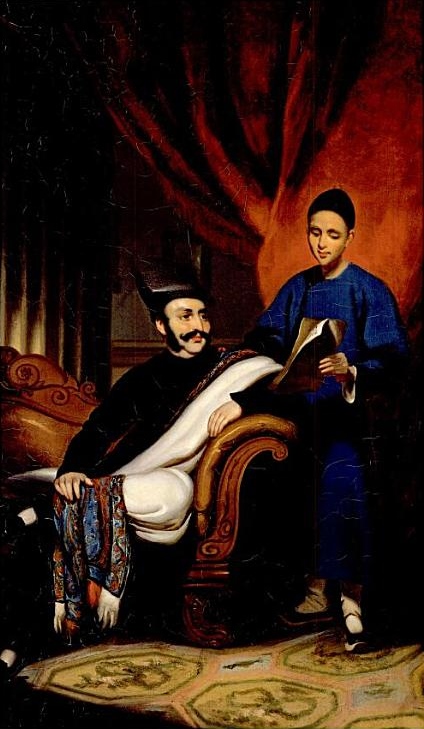|
Crawford Market Fountain
Crawford Market Fountain or Lockwood Kipling Fountain is a listed heritage structure in Crawford Market, Mumbai that was erected in 1874, and was designed by William Emerson, the British architect who also designed the market. The style is a mix of Greek Revival and Neo-Gothic, and the four carvings depicting the Indian river goddesses and native birds were done by John Lockwood Kipling (father of novelist Rudyard Kipling), who was the principal at Sir Jamsetjee Jeejebhoy School of Art. Originally, it was located in a garden courtyard setting and was meant to serve as a social space for merchants. The uncontrolled proliferation of shops around it led to a drastic change in setting, and today vegetable and fruit sellers often set up their stalls around it or use the structure to temporarily store their wares. In 1985, the crown of the fountain was damaged when a canopy was being raised over it. The Kipling river goddesses frieze was also painted over by someone with the int ... [...More Info...] [...Related Items...] OR: [Wikipedia] [Google] [Baidu] |
South Mumbai
South Mumbai, colloquially SoBo from South Bombay in Anglo-Indian English, administratively the Mumbai City District, is the city centre and the southernmost precinct of Greater Bombay. It extends from Colaba to Mahim and Sion neighbourhoods, and comprises the city's main business localities, making it the wealthiest urban precinct in India. Property prices in South Mumbai are by far the highest in India and among the highest in the world. Notably Cumballa Hills, Cuffe Parade, Malabar Hills, Breach Candy, Altamount Road-Kemps Corner as well as some parts of Worli are constantly ranked in the Global Property Index. Taj Mahal Hotel, Gateway of India, Victoria Terminus, Ballard Estate, and the Bombay Harbour are some of the most iconic landmarks of South Bombay. Billionaire Mukesh Ambani's $1.5 billion home Antilia is located here and is now a part of the iconic skyline. Most residents of South Mumbai belong to old money business, law, trade and fashion families. Geogr ... [...More Info...] [...Related Items...] OR: [Wikipedia] [Google] [Baidu] |
Sir Jamsetjee Jeejebhoy School Of Art
The Sir Jamsetjee Jeejeebhoy School of Art (Sir J. J. School of Art) is the oldest art institution in Mumbai, India, and is affiliated with the University of Mumbai. The school grants bachelor's degrees in fine art and sculpture, and Master's degrees in fine art. History Early history The School founded in March 1857, was named after Sir Jamsetjee Jeejebhoy, a businessman and philanthropist who donated Rs. 100,000 for its endowment. Operations were managed by a committee headed by the Chief Justice of Bombay. The School's first class was in drawing, and began on 2 March 1857. Classes were held at the Elphinstone Institution. John Griffiths became Principal of the School in 1865. He later became famous for copying the murals in the Ajanta Caves temple complex, a project which lasted from 1872 to 1891, and which the School's students assisted in. In 1866, management of the school was taken over by the Government of India. Also in 1866, Lockwood Kipling, who had become a profes ... [...More Info...] [...Related Items...] OR: [Wikipedia] [Google] [Baidu] |
Stone Sculptures
In geology, rock (or stone) is any naturally occurring solid mass or aggregate of minerals or mineraloid matter. It is categorized by the minerals included, its chemical composition, and the way in which it is formed. Rocks form the Earth's outer solid layer, the crust, and most of its interior, except for the liquid outer core and pockets of magma in the asthenosphere. The study of rocks involves multiple subdisciplines of geology, including petrology and mineralogy. It may be limited to rocks found on Earth, or it may include planetary geology that studies the rocks of other celestial objects. Rocks are usually grouped into three main groups: igneous rocks, sedimentary rocks and metamorphic rocks. Igneous rocks are formed when magma cools in the Earth's crust, or lava cools on the ground surface or the seabed. Sedimentary rocks are formed by diagenesis and lithification of sediments, which in turn are formed by the weathering, transport, and deposition of existing rocks. M ... [...More Info...] [...Related Items...] OR: [Wikipedia] [Google] [Baidu] |
Buildings And Structures Completed In 1874
A building, or edifice, is an enclosed structure with a roof and walls standing more or less permanently in one place, such as a house or factory (although there's also portable buildings). Buildings come in a variety of sizes, shapes, and functions, and have been adapted throughout history for a wide number of factors, from building materials available, to weather conditions, land prices, ground conditions, specific uses, prestige, and aesthetic reasons. To better understand the term ''building'' compare the list of nonbuilding structures. Buildings serve several societal needs – primarily as shelter from weather, security, living space, privacy, to store belongings, and to comfortably live and work. A building as a shelter represents a physical division of the human habitat (a place of comfort and safety) and the ''outside'' (a place that at times may be harsh and harmful). Ever since the first cave paintings, buildings have also become objects or canvasses of much artistic ... [...More Info...] [...Related Items...] OR: [Wikipedia] [Google] [Baidu] |
1874 Sculptures
Events January–March * January 1 – New York City annexes The Bronx. * January 2 – Ignacio María González becomes head of state of the Dominican Republic for the first time. * January 3 – Third Carlist War – Battle of Caspe: Campaigning on the Ebro in Aragon for the Spanish Republican Government, Colonel Eulogio Despujol surprises a Carlist force under Manuel Marco de Bello at Caspe, northeast of Alcañiz. In a brilliant action the Carlists are routed, losing 200 prisoners and 80 horses, while Despujol is promoted to Brigadier and becomes Conde de Caspe. * January 20 – The Pangkor Treaty (also known as the Pangkor Engagement), by which the British extended their control over first the Sultanate of Perak, and later the other independent Malay States, is signed. * January 23 **Prince Alfred, Duke of Edinburgh, second son of Queen Victoria, marries Grand Duchess Maria Alexandrovna of Russia, only daughter of Tsar Alexander III of Russia. * ... [...More Info...] [...Related Items...] OR: [Wikipedia] [Google] [Baidu] |
.jpg)




